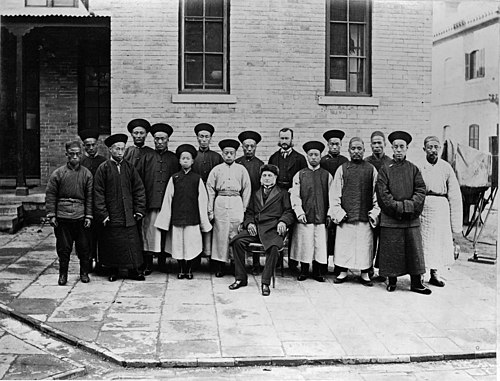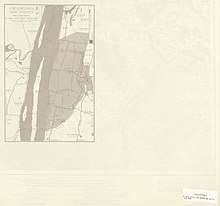Wade–Giles
Wade–Giles (/ˌweɪd ˈdʒaɪlz/) is a romanization system for Mandarin Chinese. It developed from a system produced by Thomas Francis Wade, during the mid-19th century, and was given completed form with Herbert A. Giles's Chinese–English Dictionary of 1892.
| Wade–Giles | |||||||||||||||||||||
|---|---|---|---|---|---|---|---|---|---|---|---|---|---|---|---|---|---|---|---|---|---|
| Chinese | 威翟式拼音 | ||||||||||||||||||||
| Wade–Giles | Wei1 Chai2 Shih4 Pʽin1-yin1 | ||||||||||||||||||||
| Hanyu Pinyin | Wēi-Zhái Shì Pīnyīn | ||||||||||||||||||||
| |||||||||||||||||||||
| Alternative Chinese name | |||||||||||||||||||||
| Traditional Chinese | 威妥瑪拼音 | ||||||||||||||||||||
| Simplified Chinese | 威妥玛拼音 | ||||||||||||||||||||
| Wade–Giles | Wei1 Tʽo3-ma3 Pʽin1-yin1 | ||||||||||||||||||||
| Hanyu Pinyin | Wēi Tuǒmǎ Pīnyīn | ||||||||||||||||||||
| |||||||||||||||||||||
| Second alternative Chinese name | |||||||||||||||||||||
| Traditional Chinese | 韋氏拼音 | ||||||||||||||||||||
| Simplified Chinese | 韦氏拼音 | ||||||||||||||||||||
| Wade–Giles | Wei2 Shih4 Pʽin1-yin1 | ||||||||||||||||||||
| Hanyu Pinyin | Wéi Shì Pīnyīn | ||||||||||||||||||||
| |||||||||||||||||||||
| Chinese romanization |
|---|
| Mandarin |
|
Sichuanese |
| Wu |
| Yue |
| Min |
| Gan |
|
Chang-Du dialect |
| Hakka |
| Xiang |
|
Chang–Yi dialects |
| See also |
|
Other transliterations |
Wade–Giles was the system of transcription in the English-speaking world for most of the 20th century. Wade–Giles is based on the Beijing dialect, whereas the Nanjing dialect-based romanization systems were in common use until the late 19th century. Both were used in postal romanizations (romanized place-names standardized for postal uses). In mainland China it has been mostly replaced by the Hanyu Pinyin romanization system, with exceptions for the romanized forms of some locations, persons and other proper nouns. The romanized name for some locations, persons and other proper nouns in Taiwan is based on the Wade–Giles derived romanized form, for example Kaohsiung, the Matsu Islands and Chiang Ching-kuo.
History

Wade–Giles was developed by Thomas Francis Wade, a scholar of Chinese and a British ambassador in China who was the first professor of Chinese at Cambridge University. Wade published in 1867 the first textbook on the Beijing dialect of Mandarin in English, Yü-yen Tzŭ-erh Chi (simplified Chinese: 语言自迩集; traditional Chinese: 語言自邇集),[1] which became the basis for the romanization system later known as Wade–Giles. The system, designed to transcribe Chinese terms for Chinese specialists, was further refined in 1892 by Herbert Allen Giles (in A Chinese-English Dictionary), a British diplomat in China and his son, Lionel Giles, a curator at the British Museum.[2]
Taiwan used Wade–Giles for decades as the de facto standard, co-existing with several official romanizations in succession, namely, Gwoyeu Romatzyh (1928), Mandarin Phonetic Symbols II (1986), and Tongyòng Pinyin (2000). With the election of the Kuomintang party in Taiwan in 2008, Taiwan officially switched to Hànyǔ Pīnyīn. However, many people in Taiwan, both native and overseas, use or transcribe their legal names in the Wade–Giles system, as well as the other aforementioned systems.
Initials and finals
The tables below show the Wade–Giles representation of each Chinese sound (in bold type),[3] together with the corresponding IPA phonetic symbol (in square brackets), and equivalent representations in Bopomofo and Hànyǔ Pīnyīn.
Initials
| Bilabial | Labiodental | Dental/Alveolar | Retroflex | Alveolo-palatal | Velar | |||||
|---|---|---|---|---|---|---|---|---|---|---|
| Voiceless | Voiced | Voiceless | Voiceless | Voiced | Voiceless | Voiced | Voiceless | Voiceless | ||
| Nasal | m [m] ㄇ m | n [n] ㄋ n | ||||||||
| Plosive | Unaspirated | p [p] ㄅ b | t [t] ㄉ d | k [k] ㄍ g | ||||||
| Aspirated | pʻ [pʰ] ㄆ p | tʻ [tʰ] ㄊ t | kʻ [kʰ] ㄎ k | |||||||
| Affricate | Unaspirated | ts [ts] ㄗ z | ch [ʈʂ] ㄓ zh | ch [tɕ] ㄐ j | ||||||
| Aspirated | tsʻ [tsʰ] ㄘ c | chʻ [ʈʂʰ] ㄔ ch | chʻ [tɕʰ] ㄑ q | |||||||
| Fricative | f [f] ㄈ f |
s [s] ㄙ s | sh [ʂ] ㄕ sh | hs [ɕ] ㄒ x |
h [x] ㄏ h | |||||
| Liquid | l [l] ㄌ l | j [ɻ~ʐ] ㄖ r | ||||||||
Instead of ts, tsʽ and s, Wade–Giles writes tz, tzʽ and ss before ŭ (see below).
Finals
| Coda | ||||||||||||||
|---|---|---|---|---|---|---|---|---|---|---|---|---|---|---|
| ∅ | /i/ | /u/ | /n/ | /ŋ/ | /ɻ/ | |||||||||
| Medial | ∅ | ih/ŭ [ɨ] ㄭ | ê/o [ɤ] ㄜ e | a [a] ㄚ a |
ei [ei] ㄟ ei | ai [ai] ㄞ ai |
ou [ou] ㄡ ou | ao [au] ㄠ ao |
ên [ən] ㄣ en | an [an] ㄢ an |
ung [ʊŋ] ㄨㄥ ong | êng [əŋ] ㄥ eng | ang [aŋ] ㄤ ang |
êrh [aɚ̯] ㄦ er |
| /j/ | i [i] ㄧ i | ieh [je] ㄧㄝ ie | ia [ja] ㄧㄚ ia |
iu [jou] ㄧㄡ iu | iao [jau] ㄧㄠ iao |
in [in] ㄧㄣ in | ien [jɛn] ㄧㄢ ian |
iung [jʊŋ] ㄩㄥ iong | ing [iŋ] ㄧㄥ ing | iang [jaŋ] ㄧㄤ iang |
||||
| /w/ | u [u] ㄨ u | o/uo [wo] ㄛ/ㄨㄛ o/uo | ua [wa] ㄨㄚ ua | ui/uei [wei] ㄨㄟ ui | uai [wai] ㄨㄞ uai |
un [wən] ㄨㄣ un | uan [wan] ㄨㄢ uan |
uang [waŋ] ㄨㄤ uang |
||||||
| /ɥ/ | ü [y] ㄩ ü | üeh [ɥe] ㄩㄝ üe | ün [yn] ㄩㄣ ün | üan [ɥɛn] ㄩㄢ üan |
||||||||||
Wade–Giles writes -uei after kʽ and k, otherwise -ui: kʽuei, kuei, hui, shui, chʽui.
It writes [-ɤ] as -o after kʽ, k and h, otherwise as -ê: kʽo, ko, ho, shê, chʽê. When [ɤ] forms a syllable on its own, it is written ê or o depending on the character.
Wade–Giles writes [-wo] as -uo after kʽ, k, h and sh, otherwise as -o: kʽuo, kuo, huo, shuo, chʽo.
For -ih and -ŭ, see below.
Giles's A Chinese-English Dictionary also includes the syllables chio, chʽio, hsio, yo, which are now pronounced like chüeh, chʽüeh, hsüeh, yüeh.
Syllables that begin with a medial
| Coda | ||||||||||||||
|---|---|---|---|---|---|---|---|---|---|---|---|---|---|---|
| ∅ | /i/ | /u/ | /n/ | /ŋ/ | ||||||||||
| Medial | /j/ | i/yi [i] ㄧ yi | yeh [je] ㄧㄝ ye | ya [ja] ㄧㄚ ya |
yai [jai] ㄧㄞ yai |
yu [jou] ㄧㄡ you | yao [jau] ㄧㄠ yao |
yin [in] ㄧㄣ yin | yen [jɛn] ㄧㄢ yan |
yung [jʊŋ] ㄩㄥ yong | ying [iŋ] ㄧㄥ ying | yang [jaŋ] ㄧㄤ yang | ||
| /w/ | wu [u] ㄨ wu | wo [wo] ㄨㄛ wo | wa [wa] ㄨㄚ wa |
wei [wei] ㄨㄟ wei | wai [wai] ㄨㄞ wai |
wên [wən] ㄨㄣ wen | wan [wan] ㄨㄢ wan |
wêng [wəŋ] ㄨㄥ weng | wang [waŋ] ㄨㄤ wang | |||||
| /ɥ/ | yü [y] ㄩ yu | yüeh [ɥe] ㄩㄝ yue | yün [yn] ㄩㄣ yun | yüan [ɥɛn] ㄩㄢ yuan |
||||||||||
Wade–Giles writes the syllable [i] as i or yi depending on the character.
System features
Consonants and initial symbols
A feature of the Wade–Giles system is the representation of the unaspirated-aspirated stop consonant pairs using a character resembling an apostrophe. Thomas Wade and others have used the spiritus asper (ʽ), borrowed from the polytonic orthography of the Ancient Greek language. Herbert Giles and others have used a left (opening) curved single quotation mark (‘) for the same purpose. A third group used a plain apostrophe ('). The backtick, and visually similar characters are sometimes seen in various electronic documents using the system.
Examples using the spiritus asper: p, pʽ, t, tʽ, k, kʽ, ch, chʽ. The use of this character preserves b, d, g, and j for the romanization of Chinese varieties containing voiced consonants, such as Shanghainese (which has a full set of voiced consonants) and Min Nan (Hō-ló-oē) whose century-old Pe̍h-ōe-jī (POJ, often called Missionary Romanization) is similar to Wade–Giles. POJ, Legge romanization, Simplified Wade, and EFEO Chinese transcription use the letter ⟨h⟩ instead of an apostrophe-like character to indicate aspiration. (This is similar to the obsolete IPA convention before the revisions of the 1970s). The convention of an apostrophe-like character or ⟨h⟩ to denote aspiration is also found in romanizations of other Asian languages, such as McCune–Reischauer for Korean and ISO 11940 for Thai.
People unfamiliar with Wade–Giles often ignore the spiritus asper, sometimes omitting them when copying texts, unaware that they represent vital information. Hànyǔ Pīnyīn addresses this issue by employing the Latin letters customarily used for voiced stops, unneeded in Mandarin, to represent the unaspirated stops: b, p, d, t, g, k, j, q, zh, ch.
Partly because of the popular omission of apostrophe-like characters, the four sounds represented in Hànyǔ Pīnyīn by j, q, zh, and ch often all become ch, including in many proper names. However, if the apostrophe-like characters are kept, the system reveals a symmetry that leaves no overlap:
Vowels and final symbols
Syllabic consonants
Like Yale and Mandarin Phonetic Symbols II, Wade–Giles renders the two types of syllabic consonant (simplified Chinese: 空韵; traditional Chinese: 空韻; Wade–Giles: kʽung1-yün4; Hànyǔ Pīnyīn: kōngyùn) differently:
- -ŭ is used after the sibilants written in this position (and this position only) as tz, tzʽ and ss (Pīnyīn z, c and s).
- -ih is used after the retroflex ch, chʽ, sh, and j (Pīnyīn zh, ch, sh, and r).
These finals are both written as -ih in Tongyòng Pinyin, as -i in Hànyǔ Pīnyīn (hence distinguishable only by the initial from [i] as in li), and as -y in Gwoyeu Romatzyh and Simplified Wade. They are typically omitted in Zhùyīn (Bōpōmōfō).
| IPA | ʈ͡ʂɻ̩ | ʈ͡ʂʰɻ̩ | ʂɻ̩ | ɻɻ̩ | t͡sɹ̩ | t͡sʰɹ̩ | sɹ̩ | |
|---|---|---|---|---|---|---|---|---|
| Yale | jr | chr | shr | r | dz | tsz | sz | |
| MPS II | jr | chr | shr | r | tz | tsz | sz | |
| Wade–Giles | chih | chʻih | shih | jih | tzŭ | tzʻŭ | ssŭ | |
| Tongyòng Pinyin | jhih | chih | shih | rih | zih | cih | sih | |
| Hànyǔ Pīnyīn | zhi | chi | shi | ri | zi | ci | si | |
| Gwoyeu Romatzyh | jy | chy | shy | ry | tzy | tsy | sy | |
| Simplified Wade | chy | chhy | shy | ry | tsy | tshy | sy | |
| Zhùyīn | ㄓ | ㄔ | ㄕ | ㄖ | ㄗ | ㄘ | ㄙ | |
Vowel o
Final o in Wade–Giles has two pronunciations in modern Mandarin: [wo] and [ɤ].
What is pronounced today as a close-mid back unrounded vowel [ɤ] is written usually as ê, but sometimes as o, depending on historical pronunciation (at the time Wade–Giles was developed). Specifically, after velar initials k, kʽ and h (and a historical ng, which had been dropped by the time Wade–Giles was developed), o is used; for example, "哥" is ko1 (Pīnyīn gē) and "刻" is kʽo4[4] (Pīnyīn kè). By modern Mandarin, o after velars (and what used to be ng) have shifted to [ɤ], thus they are written as ge, ke, he and e in Pīnyīn. When [ɤ] forms a syllable on its own, Wade–Giles writes ê or o depending on the character. In all other circumstances, it writes ê.
What is pronounced today as [wo] is usually written as o in Wade–Giles, except for wo, shuo (e.g. "說" shuo1) and the three syllables of kuo, kʽuo, and huo (as in 過, 霍, etc.), which contrast with ko, kʽo, and ho that correspond to Pīnyīn ge, ke, and he. This is because characters like 羅, 多, etc. (Wade–Giles: lo2, to1; Pīnyīn: luó, duō) did not originally carry the medial [w]. In modern Mandarin, the phonemic distinction between o and -uo/wo has been lost (except in interjections when used alone), and the medial [w] is added in front of -o, creating the modern [wo].
| IPA | pwo | pʰwo | mwo | fwo | two | tʰwo | nwo | lwo | kɤ | kʰɤ | xɤ | ʈ͡ʂwo | ʈ͡ʂʰwo | ʐwo | t͡swo | t͡sʰwo | swo | ɤ | wo |
|---|---|---|---|---|---|---|---|---|---|---|---|---|---|---|---|---|---|---|---|
| Wade–Giles | po | pʻo | mo | fo | to | tʻo | no | lo | ko | kʻo | ho | cho | chʻo | jo | tso | tsʻo | so | o/ê | wo |
| Zhùyīn | ㄅㄛ | ㄆㄛ | ㄇㄛ | ㄈㄛ | ㄉㄨㄛ | ㄊㄨㄛ | ㄋㄨㄛ | ㄌㄨㄛ | ㄍㄜ | ㄎㄜ | ㄏㄜ | ㄓㄨㄛ | ㄔㄨㄛ | ㄖㄨㄛ | ㄗㄨㄛ | ㄘㄨㄛ | ㄙㄨㄛ | ㄜ | ㄨㄛ |
| Pīnyīn | bo | po | mo | fo | duo | tuo | nuo | luo | ge | ke | he | zhuo | chuo | ruo | zuo | cuo | suo | e | wo |
Note that Zhùyīn and Pīnyīn write [wo] as ㄛ -o after ㄅ b, ㄆ p, ㄇ m and ㄈ f, and as ㄨㄛ -uo after all other initials.
Tones
Tones are indicated in Wade–Giles using superscript numbers (1–4) placed after the syllable. This contrasts with the use of diacritics to represent the tones in Pīnyīn. For example, the Pīnyīn qiàn (fourth tone) has the Wade–Giles equivalent chʽien4.
| Tone | Sample text | Hanyu pinyin | Wade–Giles |
|---|---|---|---|
| 1. high | 妈; 媽; 'mom' | mā | ma1 |
| 2. rising | 麻; 'hemp'[lower-alpha 1] | má | ma2 |
| 3. low (dipping) | 码; 碼; 'digit, code' | mǎ | ma3 |
| 4. falling | 骂; 罵; 'scold' | mà | ma4 |
| 5. neutral[lower-alpha 2] | 吗; 嗎; (interrogative) | ma | ma |
- Simplified and traditional characters are the same
- See neutral tone for more.
Punctuation
Wade–Giles uses hyphens to separate all syllables within a word (whereas Pīnyīn separates syllables only in specially defined cases, using hyphens or closing (right) single quotation marks as appropriate).
If a syllable is not the first in a word, its first letter is not capitalized, even if it is part of a proper noun. The use of apostrophe-like characters, hyphens, and capitalization is frequently not observed in place names and personal names. For example, the majority of overseas Taiwanese people write their given names like "Tai Lun" or "Tai-Lun", whereas the Wade–Giles is actually "Tai-lun". (See also Chinese names.)
Comparison with other systems
Pinyin
- Wade–Giles chose the French-like ⟨j⟩ (implying a sound like IPA's [ʒ], as in s in English measure) to represent a Northern Mandarin pronunciation of what is represented as ⟨r⟩ in pinyin (Northern Mandarin [ʐ]/ Southern Mandarin [ɻ]; generally considered allophones).
- Ü (representing /y/) always has an umlaut above, while pinyin only employs it in the cases of nü, nüe, lü, lüe and lüan, while leaving it out after j, q, x and y as a simplification because ⟨u⟩/[u] cannot otherwise appear after those letters. (The vowel ⟨u⟩/[u] can occur in those cases in pinyin where the diaeresis are indicated ⟨ü⟩/[y] or [ɥ]; in which cases it serves to distinguish the front vowel [y] from the back vowel [u]. By contrast it is always present to mark the front vowel in Wade–Giles.) Because yü (as in 玉 "jade") must have an umlaut in Wade–Giles, the umlaut-less yu in Wade–Giles is freed up for what corresponds to you (有 "have"/"there is") in Pinyin.
- The Pīnyīn cluster ⟨-ong⟩ is ⟨-ung⟩ in Wade–Giles, reflecting the pronunciation of [ʊ] as in English book /bʊk/. (Compare kung1-fu to gōngfu as an example.)
- After a consonant, both Wade–Giles and Pīnyīn use ⟨-iu⟩ and ⟨-un⟩ instead of the complete syllables: ⟨-iou⟩ and ⟨-uên⟩/⟨-uen⟩.
Chart
| IPA | a | ɔ | ɛ | ɤ | ai | ei | au | ou | an | ən | aŋ | əŋ | ʊŋ | aɚ |
|---|---|---|---|---|---|---|---|---|---|---|---|---|---|---|
| Pinyin | a | o | ê | e | ai | ei | ao | ou | an | en | ang | eng | ong | er |
| Tongyong Pinyin | e | e | ||||||||||||
| Wade–Giles | eh | ê/o | ên | êng | ung | êrh | ||||||||
| Bopomofo | ㄚ | ㄛ | ㄝ | ㄜ | ㄞ | ㄟ | ㄠ | ㄡ | ㄢ | ㄣ | ㄤ | ㄥ | ㄨㄥ | ㄦ |
| example | 阿 | 哦 | 呗/唄 | 俄 | 艾 | 黑 | 凹 | 偶 | 安 | 恩 | 昂 | 冷 | 中 | 二 |
| IPA | i | je | jou | jɛn | in | iŋ | jʊŋ | u | wo | wei | wən | wəŋ | y | ɥe | ɥɛn | yn |
|---|---|---|---|---|---|---|---|---|---|---|---|---|---|---|---|---|
| Pinyin | yi | ye | you | yan | yin | ying | yong | wu | wo/o | wei | wen | weng | yu | yue | yuan | yun |
| Tongyong Pinyin | wun | wong | ||||||||||||||
| Wade–Giles | i/yi | yeh | yu | yen | yung | wên | wêng | yü | yüeh | yüan | yün | |||||
| Bopomofo | ㄧ | ㄧㄝ | ㄧㄡ | ㄧㄢ | ㄧㄣ | ㄧㄥ | ㄩㄥ | ㄨ | ㄨㄛ/ㄛ | ㄨㄟ | ㄨㄣ | ㄨㄥ | ㄩ | ㄩㄝ | ㄩㄢ | ㄩㄣ |
| example | 一 | 也 | 又 | 言 | 音 | 英 | 用 | 五 | 我 | 位 | 文 | 翁 | 玉 | 月 | 元 | 云/雲 |
| IPA | p | pʰ | m | fəŋ | tjou | twei | twən | tʰɤ | ny | ly | kɤɚ | kʰɤ | xɤ |
|---|---|---|---|---|---|---|---|---|---|---|---|---|---|
| Pinyin | b | p | m | feng | diu | dui | dun | te | nü | lü | ger | ke | he |
| Tongyong Pinyin | fong | diou | duei | nyu | lyu | ||||||||
| Wade–Giles | p | pʻ | fêng | tiu | tui | tun | tʻê | nü | lü | kor | kʻo | ho | |
| Bopomofo | ㄅ | ㄆ | ㄇ | ㄈㄥ | ㄉㄧㄡ | ㄉㄨㄟ | ㄉㄨㄣ | ㄊㄜ | ㄋㄩ | ㄌㄩ | ㄍㄜㄦ | ㄎㄜ | ㄏㄜ |
| example | 玻 | 婆 | 末 | 封 | 丟 | 兑/兌 | 顿/頓 | 特 | 女 | 旅 | 歌儿/歌兒 | 可 | 何 |
| IPA | tɕjɛn | tɕjʊŋ | tɕʰin | ɕɥɛn | ʈʂɤ | ʈʂɨ | ʈʂʰɤ | ʈʂʰɨ | ʂɤ | ʂɨ | ɻɤ | ɻɨ | tsɤ | tswo | tsɨ | tsʰɤ | tsʰɨ | sɤ | sɨ |
|---|---|---|---|---|---|---|---|---|---|---|---|---|---|---|---|---|---|---|---|
| Pinyin | jian | jiong | qin | xuan | zhe | zhi | che | chi | she | shi | re | ri | ze | zuo | zi | ce | ci | se | si |
| Tongyong Pinyin | jyong | cin | syuan | jhe | jhih | chih | shih | rih | zih | cih | sih | ||||||||
| Wade–Giles | chien | chiung | chʻin | hsüan | chê | chih | chʻê | chʻih | shê | shih | jê | jih | tsê | tso | tzŭ | tsʻê | tzʻŭ | sê | ssŭ |
| Bopomofo | ㄐㄧㄢ | ㄐㄩㄥ | ㄑㄧㄣ | ㄒㄩㄢ | ㄓㄜ | ㄓ | ㄔㄜ | ㄔ | ㄕㄜ | ㄕ | ㄖㄜ | ㄖ | ㄗㄜ | ㄗㄨㄛ | ㄗ | ㄘㄜ | ㄘ | ㄙㄜ | ㄙ |
| example | 件 | 窘 | 秦 | 宣 | 哲 | 之 | 扯 | 赤 | 社 | 是 | 惹 | 日 | 仄 | 左 | 字 | 策 | 次 | 色 | 斯 |
| IPA | ma˥˥ | ma˧˥ | ma˨˩˦ | ma˥˩ | ma |
|---|---|---|---|---|---|
| Pinyin | mā | má | mǎ | mà | ma |
| Tongyong Pinyin | ma | må | |||
| Wade–Giles | ma1 | ma2 | ma3 | ma4 | ma |
| Bopomofo | ㄇㄚ | ㄇㄚˊ | ㄇㄚˇ | ㄇㄚˋ | ˙ㄇㄚ |
| example (Chinese characters) | 妈/媽 | 麻 | 马/馬 | 骂/罵 | 吗/嗎 |
Note: In Hànyǔ Pīnyīn, the so-called neutral tone is written leaving the syllable with no diacritic mark at all. In Tongyòng Pinyin, a ring is written over the vowel.
Adaptations
There are several adaptations of Wade–Giles.
Mathews
The Romanization system used in the 1943 edition of Mathews' Chinese–English Dictionary differs from Wade–Giles in the following ways:[5]
- It uses the right apostrophe: pʼ, tʼ, kʼ, chʼ, tsʼ, tzʼŭ; while Wade–Giles uses the left apostrophe, similar to the aspiration diacritic used in the International Phonetic Alphabet before the revisions of the 1970s: pʽ, tʽ, kʽ, chʽ, tsʽ, tzʽŭ.
- It consistently uses i for the syllable [i], while Wade–Giles uses i or yi depending on the character.
- It uses o for the syllable [ɤ], while Wade–Giles uses ê or o depending on the character.
- It offers the choice between ssŭ and szŭ, while Wade–Giles requires ssŭ.
- It does not use the spellings chio, chʽio, hsio, yo, replacing them with chüeh, chʽüeh, hsüeh, yüeh in accordance with their modern pronunciations.
- It uses an underscored 3 to denote a second tone which comes from an original third tone, but only if the following syllable has the neutral tone and the tone sandhi is therefore not predictable: hsiao3•chieh.
- It denotes the neutral tone by placing a dot (if the neutral tone is compulsory) or a circle (if the neutral tone is optional) before the syllable. The dot or circle replaces the hyphen.
Table
Gallery
See also
References
- Kaske, Elisabeth (2008). The Politics of Language in Chinese Education: 1895 - 1919. BRILL. p. 68. ISBN 90-04-16367-0.
- "Chinese Language Transliteration Systems – Wade–Giles". UCLA film and television archive. Archived from the original on 28 January 2007. Retrieved 4 August 2007. (Web archive)
- A Chinese-English Dictionary.
- A Chinese-English Dictionary, p. 761.
- Mathews' Chinese-English Dictionary.
Further reading
External links
- Chinese Romanization Converter – Convert between Hànyǔ Pīnyīn, Wade–Giles, Gwoyeu Romatzyh and other known or (un-)common Romanization systems.
- A conversion table of Chinese provinces and cities from Wade–Giles to Pīnyīn
- Pinyin4j: Java library supporting Chinese to Wade–Giles – Support Simplified and Traditional Chinese; Support most popular Romanization systems, including Hànyŭ Pīnyīn, Tongyòng Pinyin, Wade–Giles, MPS2, Yale and Gwoyeu Romatzyh; Support multiple pronunciations of a single character; Support customized output, such as ü or tone marks.
- Chinese without a teacher, Chinese phrasebook by Herbert Giles with Romanization
- Chinese Phonetic Conversion Tool – Converts between Wade–Giles and other formats
- Wade–Giles Annotation – Wade–Giles pronunciation and English definitions for Chinese text snippets or web pages.
- 國語拼音對照表 (in Chinese)


